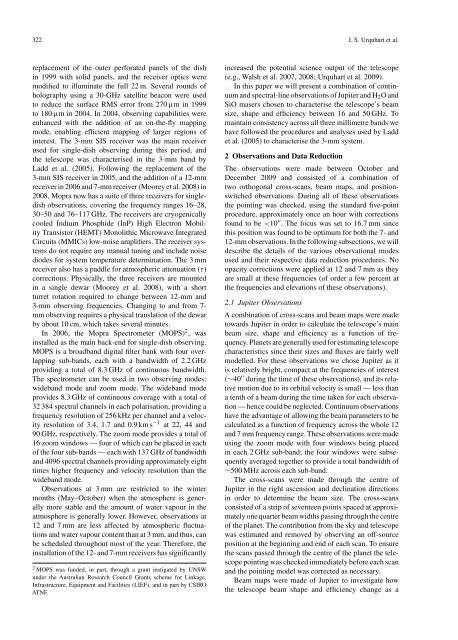Urquhart et al. 2010. - Australia Telescope Compact Array - Australia ...
Urquhart et al. 2010. - Australia Telescope Compact Array - Australia ...
Urquhart et al. 2010. - Australia Telescope Compact Array - Australia ...
You also want an ePaper? Increase the reach of your titles
YUMPU automatically turns print PDFs into web optimized ePapers that Google loves.
322 J. S. <strong>Urquhart</strong> <strong>et</strong> <strong>al</strong>.<br />
replacement of the outer perforated panels of the dish<br />
in 1999 with solid panels, and the receiver optics were<br />
modified to illuminate the full 22 m. Sever<strong>al</strong> rounds of<br />
holography using a 30-GHz satellite beacon were used<br />
to reduce the surface RMS error from 270 μm in 1999<br />
to 180 μm in 2004. In 2004, observing capabilities were<br />
enhanced with the addition of an on-the-fly mapping<br />
mode, enabling efficient mapping of larger regions of<br />
interest. The 3-mm SIS receiver was the main receiver<br />
used for single-dish observing during this period, and<br />
the telescope was characterised in the 3-mm band by<br />
Ladd <strong>et</strong> <strong>al</strong>. (2005). Following the replacement of the<br />
3-mm SIS receiver in 2005, and the addition of a 12-mm<br />
receiver in 2006 and 7-mm receiver (Moorey <strong>et</strong> <strong>al</strong>. 2008) in<br />
2008, Mopra now has a suite of three receivers for singledish<br />
observations, covering the frequency ranges 16–28,<br />
30–50 and 76–117 GHz. The receivers are cryogenic<strong>al</strong>ly<br />
cooled Indium Phosphide (InP) High Electron Mobility<br />
Transistor (HEMT) Monolithic Microwave Integrated<br />
Circuits (MMICs) low-noise amplifiers. The receiver systems<br />
do not require any manu<strong>al</strong> tuning and include noise<br />
diodes for system temperature d<strong>et</strong>ermination. The 3 mm<br />
receiver <strong>al</strong>so has a paddle for atmospheric attenuation (τ)<br />
corrections. Physic<strong>al</strong>ly, the three receivers are mounted<br />
in a single dewar (Moorey <strong>et</strong> <strong>al</strong>. 2008), with a short<br />
turr<strong>et</strong> rotation required to change b<strong>et</strong>ween 12-mm and<br />
3-mm observing frequencies. Changing to and from 7mm<br />
observing requires a physic<strong>al</strong> translation of the dewar<br />
by about 10 cm, which takes sever<strong>al</strong> minutes.<br />
In 2006, the Mopra Spectrom<strong>et</strong>er (MOPS) 2 , was<br />
inst<strong>al</strong>led as the main back-end for single-dish observing.<br />
MOPS is a broadband digit<strong>al</strong> filter bank with four overlapping<br />
sub-bands, each with a bandwidth of 2.2 GHz<br />
providing a tot<strong>al</strong> of 8.3 GHz of continuous bandwidth.<br />
The spectrom<strong>et</strong>er can be used in two observing modes:<br />
wideband mode and zoom mode. The wideband mode<br />
provides 8.3 GHz of continuous coverage with a tot<strong>al</strong> of<br />
32 384 spectr<strong>al</strong> channels in each polarisation, providing a<br />
frequency resolution of 256 kHz per channel and a velocity<br />
resolution of 3.4, 1.7 and 0.9 km s −1 at 22, 44 and<br />
90 GHz, respectively. The zoom mode provides a tot<strong>al</strong> of<br />
16 zoom windows — four of which can be placed in each<br />
of the four sub-bands — each with 137 GHz of bandwidth<br />
and 4096 spectr<strong>al</strong> channels providing approximately eight<br />
times higher frequency and velocity resolution than the<br />
wideband mode.<br />
Observations at 3 mm are restricted to the winter<br />
months (May–October) when the atmosphere is gener<strong>al</strong>ly<br />
more stable and the amount of water vapour in the<br />
atmosphere is gener<strong>al</strong>ly lower. However, observations at<br />
12 and 7 mm are less affected by atmospheric fluctuations<br />
and water vapour content than at 3 mm, and thus, can<br />
be scheduled throughout most of the year. Therefore, the<br />
inst<strong>al</strong>lation of the 12- and 7-mm receivers has significantly<br />
2 MOPS was funded, in part, through a grant instigated by UNSW<br />
under the Austr<strong>al</strong>ian Research Council Grants scheme for Linkage,<br />
Infrastructure, Equipment and Facilities (LIEF), and in part by CSIRO<br />
ATNF.<br />
increased the potenti<strong>al</strong> science output of the telescope<br />
(e.g., W<strong>al</strong>sh <strong>et</strong> <strong>al</strong>. 2007, 2008; <strong>Urquhart</strong> <strong>et</strong> <strong>al</strong>. 2009).<br />
In this paper we will present a combination of continuum<br />
and spectr<strong>al</strong>-line observations of Jupiter and H2O and<br />
SiO masers chosen to characterise the telescope’s beam<br />
size, shape and efficiency b<strong>et</strong>ween 16 and 50 GHz. To<br />
maintain consistency across <strong>al</strong>l three millim<strong>et</strong>re bands we<br />
have followed the procedures and an<strong>al</strong>yses used by Ladd<br />
<strong>et</strong> <strong>al</strong>. (2005) to characterise the 3-mm system.<br />
2 Observations and Data Reduction<br />
The observations were made b<strong>et</strong>ween October and<br />
December 2009 and consisted of a combination of<br />
two orthogon<strong>al</strong> cross-scans, beam maps, and positionswitched<br />
observations. During <strong>al</strong>l of these observations<br />
the pointing was checked, using the standard five-point<br />
procedure, approximately once an hour with corrections<br />
found to be


